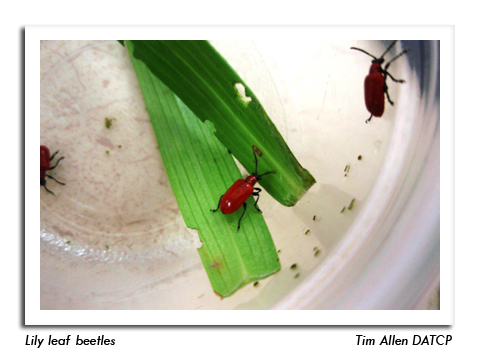
 |
|
|
Nursery & Forest
Volume 58 Number 12 Date 07/24/2014 LILY LEAF BEETLE NEW STATE RECORD - The distinct red beetles and black, slug-like larvae found on lily foliage at a nursery in Marathon County on June 25 have been identified by UW and DATCP entomologists as the lily leaf beetle, Lillioceris lilii, a very destructive pest of true lilies and fritillaria. This is the first confirmed report of the lily leaf beetle (LLB) in Wisconsin and a new state record. A native of Europe and Asia, the LLB was first officially documented in the United States in 1992. It is thought to have arrived in a shipment of lily bulbs from Europe. This exotic species has no effective North American natural enemies and poses a potential economic threat to horticulturists, as well as an environmental threat to native lilies. Its primary host plants are true lillies (Asiatic and Oriental, Easter, Turk's cap, tiger) and fritillaria (Fritillaria spp.), though bittersweet, hollyhock, lily of the valley, Solomon's seal, and potato have also been reported as host. Daylilies are not considered hosts. The full extent of the Wisconsin infestation has not been determined. Beetles and larvae have thus far been found in three separate locations--Mosinee, Kronenwetter and Rothschild--all within an approximately 15-mile radius in Marathon County. Residents, gardeners and nursery operators who observe small red beetles or larvae on their lilies and suspect it may be LLB are encouraged to report their observations to the DATCP Nursery Program at datcpnursery@wisconsin.gov. FLEA BEETLE - A variety of flea beetle species were observed this week on elderberry, elm, forsythia, hydrangea, and weigela at garden centers in Dodge, Fond du Lac, Jackson, Milwaukee, Polk, and St. Croix counties. These tiny beetles chew small pits on the underside of foliage that eventually dry up and fall out, leaving small circular holes in the leaves. Heavy feeding pressure can result in plant wilting or stunting. Most flea beetles prefer vegetable crops, but ornamental flowers, shrubs and trees are also susceptible to attack. Chemical control is occasionally warranted to reduce damage to nursery stock. HACKBERRY NIPPLE GALL - Hackberry trees across much of the state are showing infestations of this gall-making insect. The prominent galls develop on the undersides of the leaves in response to feeding by the tiny, yellowish-orange psyllid nymph. Hackberry is the only known host of this psyllid. In most cases, the galls are an aesthetic issue that has no impact on tree health. Control is seldom necessary. ERIOPHYID MITE - Light to moderate infestations of this mite were found on fragrant sumac, linden, maple, river birch and viburnum in Dodge, Milwaukee and Polk counties. Their pattern of feeding causes very distinct erineum galls essentially a mass of leaf hairs containing thousands of tiny mites to develop on the undersides of leaves. Damaged foliage becomes wrinkled and turns reddish. Activity should subside next month and no control is needed at this time. Pruning dormant woody trees and shrubs in early spring may help reduce numbers of overwintering mites on bud scales. -- Ellen Hermanson, DATCP Nursery Inspector 




|
|
|